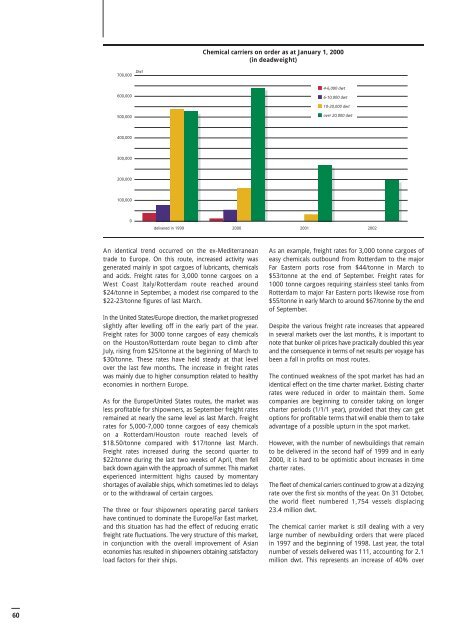You also want an ePaper? Increase the reach of your titles
YUMPU automatically turns print PDFs into web optimized ePapers that Google loves.
60<br />
700,000<br />
600,000<br />
500,000<br />
400,000<br />
300,000<br />
200,000<br />
100,000<br />
0<br />
Dwt<br />
An identical trend occurred on the ex-Mediterranean<br />
trade <strong>to</strong> Europe. On this route, increased activity was<br />
generated mainly in spot cargoes of lubricants, chemicals<br />
and acids. Freight rates for 3,000 <strong>to</strong>nne cargoes on a<br />
West Coast Italy/Rotterdam route reached around<br />
$24/<strong>to</strong>nne in September, a modest rise compared <strong>to</strong> the<br />
$22-23/<strong>to</strong>nne figures of last March.<br />
In the United States/Europe direction, the market progressed<br />
slightly after levelling off in the early part of the year.<br />
Freight rates for 3000 <strong>to</strong>nne cargoes of easy chemicals<br />
on the Hous<strong>to</strong>n/Rotterdam route began <strong>to</strong> climb after<br />
July, rising from $25/<strong>to</strong>nne at the beginning of March <strong>to</strong><br />
$30/<strong>to</strong>nne. These rates have held steady at that level<br />
over the last few months. The increase in freight rates<br />
was mainly due <strong>to</strong> higher consumption related <strong>to</strong> healthy<br />
economies in northern Europe.<br />
As for the Europe/United States routes, the market was<br />
less profitable for shipowners, as September freight rates<br />
remained at nearly the same level as last March. Freight<br />
rates for 5,000-7,000 <strong>to</strong>nne cargoes of easy chemicals<br />
on a Rotterdam/Hous<strong>to</strong>n route reached levels of<br />
$18.50/<strong>to</strong>nne compared with $17/<strong>to</strong>nne last March.<br />
Freight rates increased during the second quarter <strong>to</strong><br />
$22/<strong>to</strong>nne during the last two weeks of April, then fell<br />
back down again with the approach of summer. This market<br />
experienced intermittent highs caused by momentary<br />
shortages of available ships, which sometimes led <strong>to</strong> delays<br />
or <strong>to</strong> the withdrawal of certain cargoes.<br />
The three or four shipowners operating parcel tankers<br />
have continued <strong>to</strong> dominate the Europe/Far East market,<br />
and this situation has had the effect of reducing erratic<br />
freight rate fluctuations. The very structure of this market,<br />
in conjunction with the overall improvement of Asian<br />
economies has resulted in shipowners obtaining satisfac<strong>to</strong>ry<br />
load fac<strong>to</strong>rs for their ships.<br />
Chemical carriers on order as at January 1, 2000<br />
(in deadweight)<br />
4-6,000 dwt<br />
6-10,000 dwt<br />
10-20,000 dwt<br />
over 20,000 dwt<br />
delivered in 1999 2000 2001 2002<br />
As an example, freight rates for 3,000 <strong>to</strong>nne cargoes of<br />
easy chemicals outbound from Rotterdam <strong>to</strong> the major<br />
Far Eastern ports rose from $44/<strong>to</strong>nne in March <strong>to</strong><br />
$53/<strong>to</strong>nne at the end of September. Freight rates for<br />
1000 <strong>to</strong>nne cargoes requiring stainless steel tanks from<br />
Rotterdam <strong>to</strong> major Far Eastern ports likewise rose from<br />
$55/<strong>to</strong>nne in early March <strong>to</strong> around $67/<strong>to</strong>nne by the end<br />
of September.<br />
Despite the various freight rate increases that appeared<br />
in several markets over the last months, it is important <strong>to</strong><br />
note that bunker oil prices have practically doubled this year<br />
and the consequence in terms of net results per voyage has<br />
been a fall in profits on most routes.<br />
The continued weakness of the spot market has had an<br />
identical effect on the time charter market. Existing charter<br />
rates were reduced in order <strong>to</strong> maintain them. Some<br />
companies are beginning <strong>to</strong> consider taking on longer<br />
charter periods (1/1/1 year), provided that they can get<br />
options for profitable terms that will enable them <strong>to</strong> take<br />
advantage of a possible upturn in the spot market.<br />
However, with the number of newbuildings that remain<br />
<strong>to</strong> be delivered in the second half of 1999 and in early<br />
2000, it is hard <strong>to</strong> be optimistic about increases in time<br />
charter rates.<br />
The fleet of chemical carriers continued <strong>to</strong> grow at a dizzying<br />
rate over the first six months of the year. On 31 Oc<strong>to</strong>ber,<br />
the world fleet numbered 1,754 vessels displacing<br />
23.4 million dwt.<br />
The chemical carrier market is still dealing with a very<br />
large number of newbuilding <strong>orders</strong> that were placed<br />
in 1997 and the beginning of 1998. Last year, the <strong>to</strong>tal<br />
number of vessels delivered was 111, accounting for 2.1<br />
million dwt. This represents an increase of 40% over


